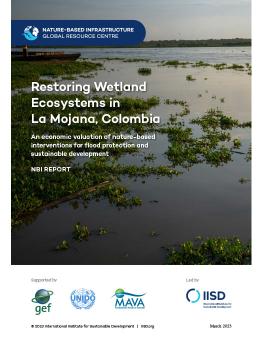
Restoring Wetland Ecosystems in La Mojana, Colombia
Economic valuation of restoring wetland ecosystems in Colombia
This report presents a Sustainable Asset Valuation (SAVi) of infrastructure interventions to reduce floods in Colombia's La Mojana region. We use spatial models, system dynamics modelling, and economic analysis to assess the societal costs and benefits of restoring wetlands and channels, implementing sustainable agriculture practices and building dams along the Cauca River. The economic valuation demonstrates that these investments can significantly reduce flood damages and contribute to sustainable development in La Mojana.
La Mojana is a highly biodiverse region with vast swamps, forests, canals, and rivers in northern Colombia. Yet, it is also one of the poorest regions in Colombia and is highly vulnerable to the impacts of climate change, especially floods and droughts. Government stakeholders and international organizations are therefore searching for infrastructure options that mitigate floods and water scarcity while supporting local livelihoods and healthy ecosystems.
In this integrated assessment, we analyze the performance of different infrastructure options for flood mitigation in La Mojana:
- A grey infrastructure scenario in which the existing dam along the Cauca River is reinforced, and 50 km of new dam is built.
- Two nature-based infrastructure (NBI) scenarios that entail the restoration of channels to increase drainage to retention areas and a scenario that considers the rehabilitation of wetland areas to increase the buffer capacity for floods.
- A scenario that considers the implementation of sustainable agriculture practices that increase sectoral productivity but only marginally reduce flood damages.
- A scenario that includes a combination of the dam and NBI interventions. We compare these investments to a business-as-usual scenario in which the existing dam remains unchanged, and no additional measures are taken.
Key findings:
- All interventions considered to reduce flooding are investment worthy—with benefit-to-cost ratios ranging from 2.07 to 26.1.
- Additional dam construction, channel and wetland rehabilitation, and sustainable agriculture could avoid more than USD 1.26 billion (COP 6131 billion) in flood damages to buildings, roads, and agriculture over the next 30 years.
- The largest economic gains from flood protection investments are the avoided damages to buildings and roads and the increased revenue generation and labour income from agricultural production that will be made possible thanks to better water management. This finding illustrates the importance of estimating such co-benefits and taking them into account when planning and deciding on the required interventions.
The report is complemented by a technical annex with methodological details about the system dynamics model and spatial analysis that were developed for the valuation. An additional story summarizes key results and policy recommendations from the assessment.
Participating experts
You might also be interested in
How Can We Work With Nature to Tackle Drought and Desertification?
Drought is one of the most devastating and pervasive challenges exacerbated by climate change. However, we can work to reduce its effects through nature-based solutions for land restoration and climate-smart agriculture.
IISD Annual Report 2022–2023
At IISD, we’ve been working for more than three decades to create a world where people and the planet thrive. As the climate crisis unfolds on our doorsteps and irreversible tipping points loom, our team has been focused more than ever on impact.
Sustainable Asset Valuation of Land Restoration in Sodo District, Southern Ethiopia
This report presents a SAVi assessment that quantifies the social, economic, and environmental outcomes of assisted natural regeneration in Ethiopia.
The 'spongy' cities of the future
Tangled mats of muddy vegetation line the footpaths of Underwood Park, a narrow stripe of green winding along a creek beneath the small volcanic cone of Ōwairaka (Mt Albert) in Auckland, New Zealand. In the water, clumps of sticks and the occasional plastic bag are marooned on protruding rocks and branches.